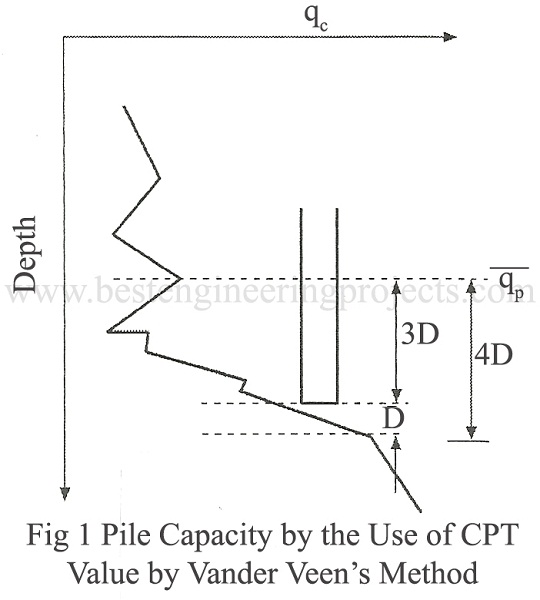Pile Capacity Based on SPT Results
On the basis of SPT results Meycrhof has suggested the following relationships for the ultimate capacity of piles.
Displacement piles
Qu = 400NAb + 2N’As ———- (1)
H Piles
Qu = 400NAb + N’As ———- (2)
Bored Piles
Qu = 133NAb + 0.67N’As ———- (3)
Where, Qu = Ultimate total load in kN
N = Average SPT value below pile tip
N’= Average SPT value along the pile shaft
As = Shaft surface area of pile in m2
Ab = Base area of pile in m2
The minimum factor of safety of 4 is recommended for driven pile. The allowable load is given by:
———- (4)
Pile Capacity Based on Static Cone Penetration (CPT) Results
The cone penetration test may be considered as a small scale pile load test. As such, the results of this test yields the necessary parameters for the design of piles subjected to vertical load.
Vander Veen’s Method for Piles in Cohesionless Soils
In the Vander Veen’s method (1951), the ultimate end bearing-resistance of a pile is taken, as being equal to the point resistance of the cone. In this method, the average cone resistance over a depth equal to three times the diameter of the pile above the pile point level and one pile diameter below point level is taken as shown in Fig.1.
The ultimate load capacity of pile is,
Qu = Qb + Qs
Base resistance
Qb = Abqp‘ ———- (5)
Where, Ab = Area of base of pile
qp‘ = Average point resistance taken over the depth 4D as shown in the Fig.1.
Shaft resistance
Meyerhof (1956) suggested the following relationships,
Large displacement piles
————–(6)
Where, qc‘ = Average point resistance along the length of the pile (kN/m2)
Small displacement piles
———- (7)
Where, qc = average cone resistance in kg/cm2 over the length of pile shaft under consideration
The allowable load is,
———- (8)
